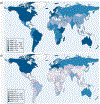Epidemiology of HPV Related Malignancies
- PMID: 34455984
- PMCID: PMC9057013
- DOI: 10.1016/j.semradonc.2021.04.001
Epidemiology of HPV Related Malignancies
Abstract
Human papillomavirus is the most common sexually transmitted infection in the world and had been linked to both anogenital and oropharyngeal cancers. It causes nearly 100% of cervical cancers and an increasing portion of oropharyngeal cancers. The geographical burden of cervical HPV infection and associated cancers is not uniform and is mainly found in low middle income countries in South America, Africa, and Asia. However, HPV-positive oropharyngeal cancer is rapidly becoming more prevalent in high middle income countries. With the development of vaccines which prevent HPV infection, the World Health Organization has designated the extirpation of HPV and its associated cancers a priority. Countries that have implemented adequate vaccine programs have shown a decrease in HPV prevalence. Understanding the epidemiology of HPV and its associated cancers is fundamental in improving vaccine programs and other health programs.
Copyright © 2021 Elsevier Inc. All rights reserved.
Figures



Similar articles
-
Epidemiology of cervical cancer and HPV infection in Asia and Oceania.J Obstet Gynaecol Res. 2024 Oct;50 Suppl 1:31-41. doi: 10.1111/jog.15943. Epub 2024 Apr 8. J Obstet Gynaecol Res. 2024. PMID: 38589341 Review.
-
Human papillomavirus in cervical cancer and oropharyngeal cancer: One cause, two diseases.Cancer. 2017 Jun 15;123(12):2219-2229. doi: 10.1002/cncr.30588. Epub 2017 Mar 27. Cancer. 2017. PMID: 28346680 Review.
-
A prophylactic quadrivalent vaccine for the prevention of infection and disease related to HPV-6, -11, -16 and -18.Expert Rev Vaccines. 2012 Apr;11(4):395-406. doi: 10.1586/erv.12.20. Expert Rev Vaccines. 2012. PMID: 22551023 Review.
-
Human papillomavirus (HPV), HPV-associated oropharyngeal cancer, and HPV vaccine in the United States--do we need a broader vaccine policy?Vaccine. 2013 Nov 12;31(47):5500-5. doi: 10.1016/j.vaccine.2013.09.031. Epub 2013 Oct 3. Vaccine. 2013. PMID: 24095883 Review.
-
Eradicating HPV-Associated Cancer Through Immunization: A Glass Half Full….Viral Immunol. 2018 Mar;31(2):80-85. doi: 10.1089/vim.2017.0119. Epub 2018 Jan 3. Viral Immunol. 2018. PMID: 29298130 Review.
Cited by
-
Information-seeking Behavior of Iranian Young Adults (18-28 Years Old) Regarding HPV on Social Media: A Preventive Approach to HPV.Int J Prev Med. 2024 Aug 30;15:41. doi: 10.4103/ijpvm.ijpvm_337_23. eCollection 2024. Int J Prev Med. 2024. PMID: 39381357 Free PMC article.
-
A population-based study using nomograms to predict overall and cancer-specific survival in HPV-associated CSCC.Cancer Sci. 2025 Feb;116(2):470-487. doi: 10.1111/cas.16392. Epub 2024 Nov 11. Cancer Sci. 2025. PMID: 39528226 Free PMC article.
-
Monitoring HPV Prevalence and Risk Cofactors for Abnormal Cytology in the Post-Vaccination Period among Croatian Women.Viruses. 2024 Apr 20;16(4):642. doi: 10.3390/v16040642. Viruses. 2024. PMID: 38675981 Free PMC article.
-
Advances and Challenges in Cervical Cancer: From Molecular Mechanisms and Global Epidemiology to Innovative Therapies and Prevention Strategies.Cancer Control. 2025 Jan-Dec;32:10732748251336415. doi: 10.1177/10732748251336415. Epub 2025 Apr 23. Cancer Control. 2025. PMID: 40267919 Free PMC article. Review.
-
Human papilloma virus (HPV) mediated cancers: an insightful update.J Transl Med. 2025 Apr 29;23(1):483. doi: 10.1186/s12967-025-06470-x. J Transl Med. 2025. PMID: 40301924 Free PMC article. Review.
References
-
- Winer RL, Koutsky LA: The Epidemiology of Human Papillomavirus Infections. In: Shah TERKV (ed). Cercival Cancer: From Etiology to Prevention, Dordrecht: Springer, 143–187, 2004
-
- Walboomers JM, Jacobs MV, Manos MM, et al.: Human papillomavirus is a necessary cause of invasive cervical cancer worldwide. The Journal of pathology 189:12–19, 1999 - PubMed
-
- Moscicki AB, Shiboski S, Broering J, et al.: The natural history of human papillomavirus infection as measured by repeated DNA testing in adolescent and young women. The Journal of pediatrics 132:277–284, 1998 - PubMed
-
- Muñoz N, Bosch FX, De Sanjosé S, et al.: Epidemiologic classification of human papillomavirus types associated with cervical cancer. New England journal of medicine 348:518–527, 2003 - PubMed

